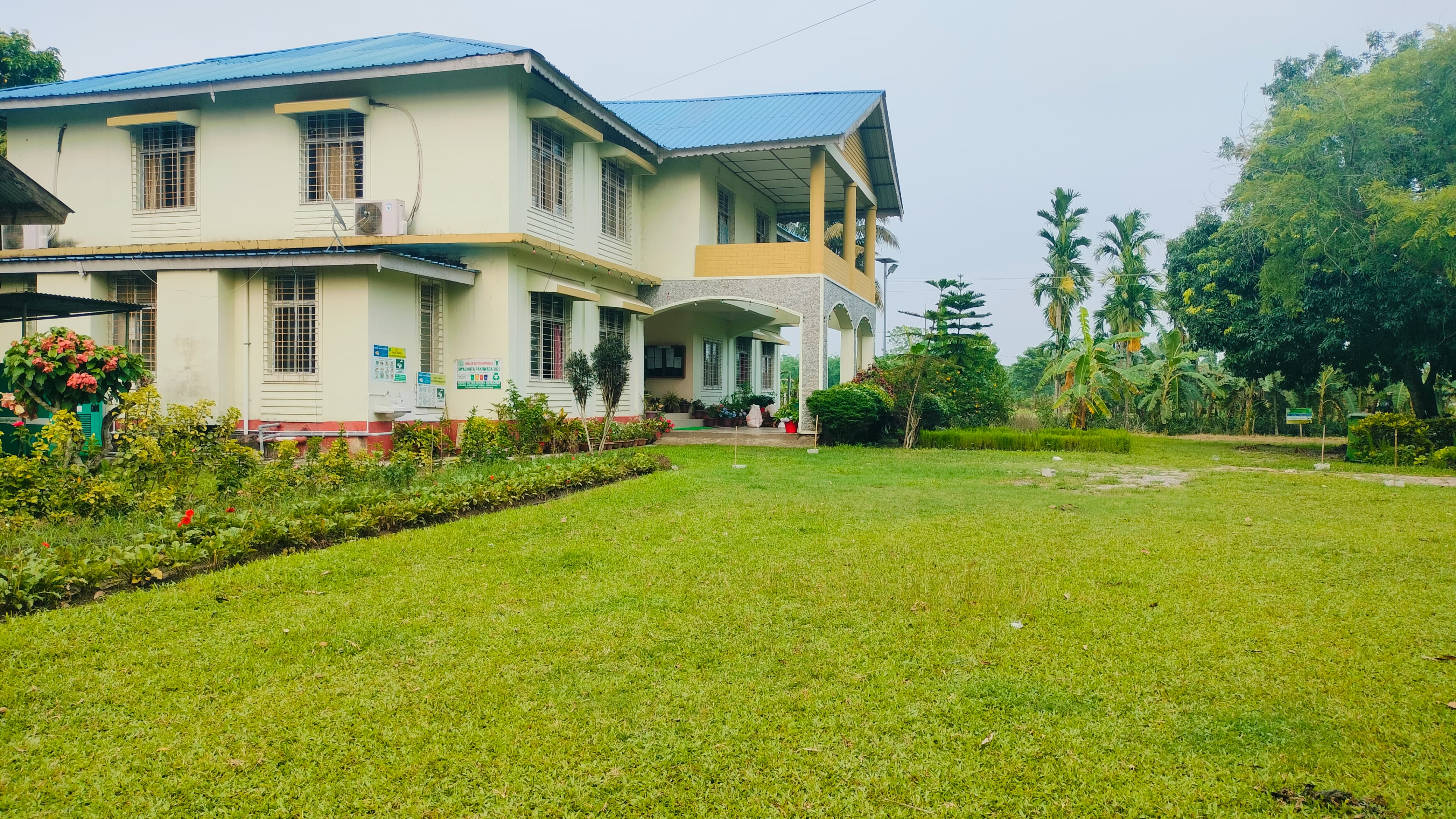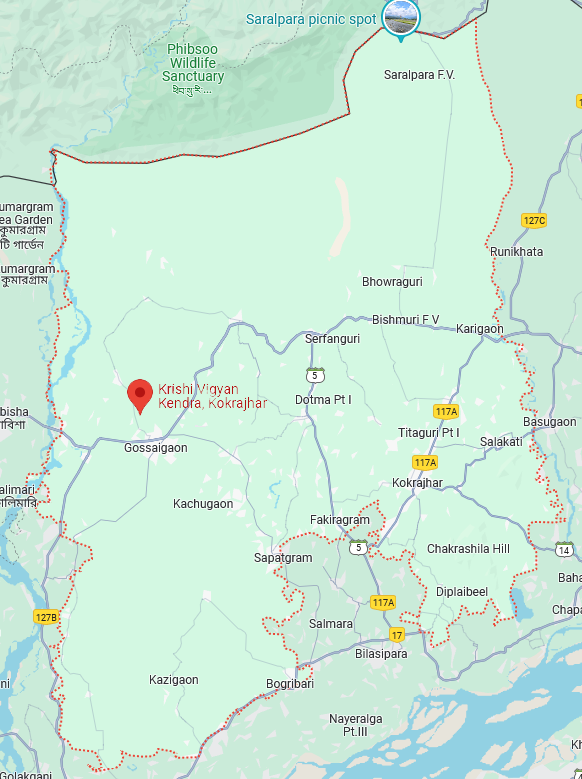
The KVK was established vide sanction order no. 3(88)/85 - KVK with financial support from the ICAR at Gossaigaon sub-division of Kokrajhar district and shares the campus with Regional Agricultural Research Station (RARS) of AAU for Lower Brahmaputra Valley Zone (LBVZ) of Assam. The distance from the district headquarter Kokrajhar to the KVK is 50 km and can be approached by both road and rail communication. The KVK lies within the boundary of Bodoland Territorial Area District (BTAD) of Assam and people surrounding it belong to Bodos,Santhals, Rajbangshi and Muslim community. Total land holding of KVK is 11.0 ha, 1.5 ha is under office building, 2.5 ha is under orchard and agro-forestry plants and land under seasonal crops are 7.0 ha. The operational area of KVK encompasses three sub-divisions viz. Kokrajhar, Gossaigaon, Parbatjhora and eight community development blocks namely Titaguri, Dotma, Gossaigaon, Kachugaon, Hatidhura, Debitola, Mahamaya and Rupshi.
The KVK is surrounded by:
North: Narang Pachani Gaon and Changmai Gaon
South: Nagadera Gaon and Tipomia Gaon
East: Sensua Gaon and Changmai Gaon
West: Adarsha Gaon and Miri Gaon


The Krishi Vigyan Kendra Kokrajhar is 502 km away from its host institute, Assam Agricultural University, Jorhat
The Krishi Vigyan Kendra Kokrajhar is 270 km away from ISBT, Guwahati
The Krishi Vigyan Kendra kokrajgar is 260 km away from Lokpriya Gopinath Bordoloi International Airport, Borjhar, Guwahati, Assam 781015
The Gossaigaon Haat is the nearest railway station for rail communication and Bagdogra, Shiliguri, West Bengal is the nearest airport located at 240 km distance.
Introduction
Krishi Vigyan Kendra (KVK) provides various types of farm support to the agricultural sector. Indian Council for Agricultural Research (ICAR) and its affiliated institutions at the district level created KVK as an agricultural extension center. The first KVK was established in 1974 at Puducherry.KVK’s mission is to assess the technology and demonstrate its application to the farmers while also building capacity. KVK is responsible for producing high-quality technological products (seed, planting materials, bio-agents, and livestock) and making them accessible to farmers, organizing frontline extension activities, identifying and documenting selected farm innovations, and converging with ongoing KVK schemes and programs.
History of Krishi Vigyan Kendra
The Education Commission (1964-66) recommended that a concerted effort be made to establish specialized institutions that would provide pre-and post-matriculate vocational education in agriculture and related fields to meet the training needs of a large number of boys and girls coming from rural areas. Furthermore, the Commission suggested that such institutions be called “Agricultural Polytechnics.” The Commission’s recommendations were thoroughly debated by the Ministry of Education, the Ministry of Agriculture, the Planning Commission, the Indian Council of Agricultural Research (ICAR), and other allied institutions between 1966 and 1972. Finally, the ICAR proposed that Krishi Vigyan Kendras (Agricultural Science Centres) be established as innovative institutions to provide vocational training to practicing farmers, school dropouts, and field-level extension functionaries. In a meeting held in August 1973, the ICAR Standing Committee on Agricultural Education stated that the establishment of Krishi Vigyan Kendras (KVKs) was of national importance because it would help in accelerating agricultural production as well as improving the socio-economic conditions of the farming community and that all related institutions should be involved in its implementation. As a result, in 1973, the ICAR formed a committee led by Dr. Mohan Singh Mehta of Seva Mandir in Udaipur (Rajasthan) to devise a detailed plan for implementing this scheme. In 1974, the Committee submitted its report.
KVK Overview
• The first KVK was established as a pilot project in Puducherry (Pondicherry) in 1974, under the administrative control of the Tamil Nadu Agricultural University in Coimbatore. There are currently 721 KVKs, with 498 belonging to State Agricultural Universities (SAU) and Central Agricultural Universities (CAU), 66 to ICAR Institutes, 104 to NGOs, 38 to State Governments, and the rest to other educational institutions.
• Agricultural universities, ICAR institutes, related government departments, and non-governmental organizations (NGOs) working in agriculture are all eligible to apply for KVKs. A KVK is usually linked to a local agricultural university.
• All KVKs are governed by one of India’s 11 Agricultural Technology Application Research Institutes (ATARIs).
• These Krishi Vigyan Kendras are entirely funded by the Indian government and are critical to meeting the government’s goal of doubling farmer income in the near future.
KVK aims & objectives
• Krishi Vigyan Kendra is critical in demonstrating location-specific agricultural technologies through on-farm testing
• Through technology assessment, refinement, and demonstrations, it aims to assess location-specific technology modules in agriculture and related enterprises. It also aspires to put agricultural research into practice in a small-scale, localized setting
• 3. Krishi Vigyan Kendras have been serving as agricultural technology knowledge and resource centers, assisting public, private, and non-profit initiatives aimed at improving the district’s agricultural economy.
Krishi Vigyan Kendra Features
• Creation of valuable resources in terms of technical manpower and assets.
• Confirmation of technologies to suit local specificity.
• Showcasing the frontier technologies.
• Capacity-building among stakeholders.
• Front runner in technological application, information, and inputs.
• Participatory approaches in planning, implementing, executing, and evaluation.